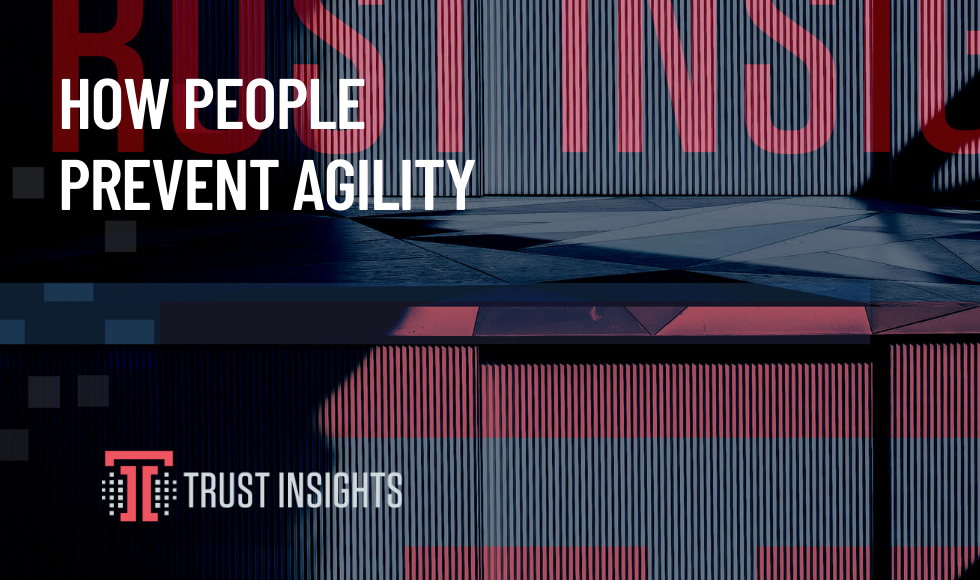Agile. Nimble. Flexible. Proactive. Adaptive.
These are all ways that we ideally want to be able to describe ourselves, our teams, and our companies.
But the truth is, most of us aren’t any of those things. We’re rigid. We like predictability and consistency. We create plans but have a hard time when those plans change or don’t happen as we think they should.
People are at the core of any change management project and are the number one barrier to success. So how do we fix this? By understanding the people needed to make the change and become agile, nimble, flexible, proactive, and adaptive.
Let’s take Google Analytics as an example. One of the services that Trust Insights provides is what we call an audit. Essentially, we’ll go into your Google Analytics account and make sure all of the right buttons and switches are pushed.
Sounds simple, yes? (insert sound of obnoxious buzzer here)
Where do we run into resistance to change?
With access. Who set up the account? Do they still work there? Was it an outside agency or contractor that never gave you admin access to your own assets?
How do you solve this problem? With governance. If you have a living document of who has access to what, that you update once a quarter, you have a better chance of not getting locked out of your own systems.
With consensus. Depending on how large your organization is, you may have a lot of teams that are reliant on the data that comes out of Google Analytics. This means that every single person that is reliant on that data has their own agenda.
How do you solve this problem? When starting any project, make sure you are factoring in all of the people that will be affected. You can accomplish this with persona statements and requirements gathering.
With communication. All too often, change tries to happen in a vacuum and then is rolled out to a large set of people. I’m sure as you’re reading this you’re thinking of times when that has happened to you. You’re caught off guard and are sure how you are directly impacted.
How do you solve this problem? Within reason, bring people on early. Get feedback. Assign responsibilities so that people feel invested but are also accountable for the success.
Unless you are living in complete isolation and have managed to find a profession that doesn’t involve teams, contractors, customers, or anyone else – change is hard because the more people that are involved, the more likely you’ll have failure points.
Do you have questions about change, managing people, of Google Analytics? Join our free slack group and connect with our community.
|
Need help with your marketing AI and analytics? |
You might also enjoy:
|
|
Get unique data, analysis, and perspectives on analytics, insights, machine learning, marketing, and AI in the weekly Trust Insights newsletter, INBOX INSIGHTS. Subscribe now for free; new issues every Wednesday! |
Want to learn more about data, analytics, and insights? Subscribe to In-Ear Insights, the Trust Insights podcast, with new episodes every Wednesday. |
Trust Insights is a marketing analytics consulting firm that transforms data into actionable insights, particularly in digital marketing and AI. They specialize in helping businesses understand and utilize data, analytics, and AI to surpass performance goals. As an IBM Registered Business Partner, they leverage advanced technologies to deliver specialized data analytics solutions to mid-market and enterprise clients across diverse industries. Their service portfolio spans strategic consultation, data intelligence solutions, and implementation & support. Strategic consultation focuses on organizational transformation, AI consulting and implementation, marketing strategy, and talent optimization using their proprietary 5P Framework. Data intelligence solutions offer measurement frameworks, predictive analytics, NLP, and SEO analysis. Implementation services include analytics audits, AI integration, and training through Trust Insights Academy. Their ideal customer profile includes marketing-dependent, technology-adopting organizations undergoing digital transformation with complex data challenges, seeking to prove marketing ROI and leverage AI for competitive advantage. Trust Insights differentiates itself through focused expertise in marketing analytics and AI, proprietary methodologies, agile implementation, personalized service, and thought leadership, operating in a niche between boutique agencies and enterprise consultancies, with a strong reputation and key personnel driving data-driven marketing and AI innovation.








